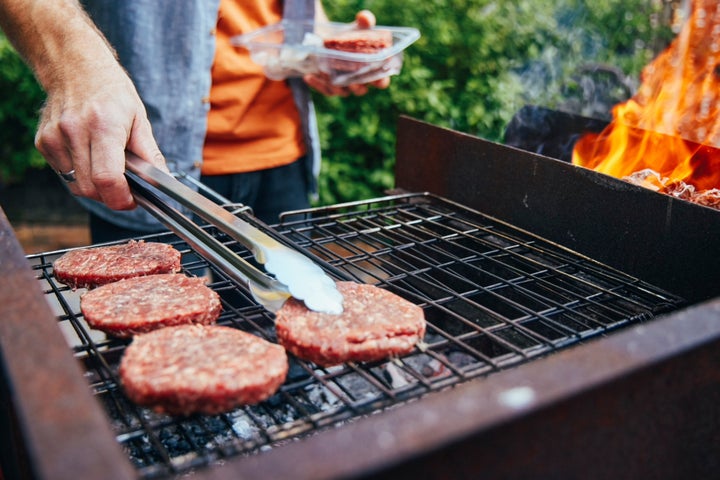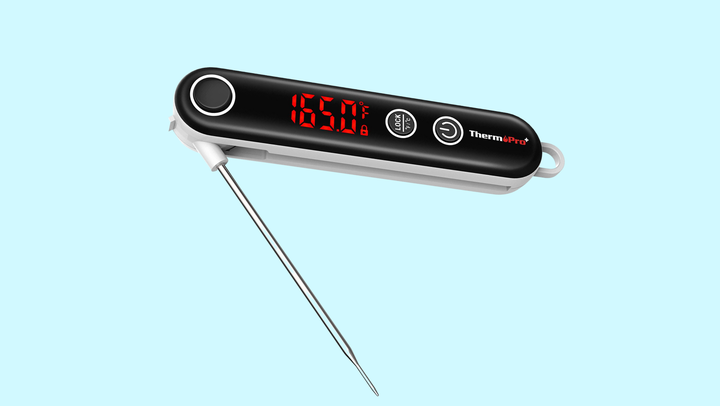
Just so you know, HuffPost UK may collect a share of sales or other compensation from the links on this page if you decide to shop from them. Oh, and FYI — prices are accurate and items in stock as of time of publication.
Doing the grilling at a barbecue get-together is a serious job. Whether you’re cooking up burgers, chicken, steak, veggies or fruit, you certainly don’t want your food to go up in smoke. Barbecueing is a tricky business – you’re literally playing with fire – and there’s not a lot of room for error.
That said, there’s one mistake in particular that grilling pros say they see again and again: not getting the temperature right.
It’s a mistake they say is often made, no matter what someone is grilling, and it can happen at different points during the grilling process. Getting the temperature of your food right is important for both taste and to protect everyone from foodborne illness. Feeling the heat? Here’s what you need to know about grilling and temperature.
Put your meat on the grill at the right time
According to Meathead Goldwyn, the founder of AmazingRibs.com and author of The Science of Great Barbecue and Grilling, temperature comes into play right at the get-go when it comes to preheating the grill.
“You do want to preheat and it usually takes 15 minutes to get the metal on the grill up to temp,” he says.
How do you know when it’s time to put your meat on? Goldwyn said the middle area around the grill should all be warm. Pretty simple, right? Now you’re ready for the main event: cooking food – and this is when temperature control becomes most important.
Properly control the heat of the grill
As with cooking food in the oven, the temperature you want the grill to be varies depending on what you’re cooking, says Susie Bulloch, the creator of the blog Hey, Grill, Hey. “With any type of grill, you have a lot of flexibility in terms of controlling the temperature,” she says. If you’re cooking something thick like steak, pork chops, or chicken, she recommends starting at a lower temperature and then finishing at a really high temperature. “That’s how you get that hot, crispy, charred taste at the end that’s really associated with grilled flavour,” she says.
Goldwyn says this is exactly why it’s important to set your grill up in two zones. “Half of the grill should be roaring hot and the other side should not be,” he advised. The hot side of the grill should have direct heat, but the other side shouldn’t; warm air from the hot side of the grill will circulate over your food, and that will be enough. If you’re grilling burgers for a large group of people, this is also key so the burgers you cook first stay hot, and also helps to accommodate guests’ varying requests of “doneness.”
How to Grill for Beginners” author Richard Sherman reiterates what Bulloch says about different types of meat requiring different types of heat. “If you’re cooking a larger piece of protein like a beef roast or whole chicken, it’s best to use indirect heat and essentially use your grill as an oven,” he says, adding that this way it cooks more evenly. “Direct heat is better for smaller pieces of meat and vegetables, cooking the food over a moderate to high flame.” But it’s not just the heat inside the grill that matters; the internal temperature of what you’re cooking is important.
Keep tabs on the internal temperature of your food
This is when having a cooking thermometer is key – they can range in price from basic to top-of-the-line. “It will give you a precision reading within two to five seconds, which is important because internal temperature can change very quickly.” Sherman co-signs this, saying chicken and lean pork in particular have a small window of doneness.

Goldwyn said one major reason it’s important to use a cooking thermometer is because if meat isn’t cooked enough, it puts eaters at risk of foodborne illness. The US Food Safety and Inspection Service says the internal temperature of ground meat should be 160°F (71°C), 165°F (74°C) or turkey and chicken, and 145°F (63°C) for steak and pork. Despite this, Goldwyn recommends steak should be cooked to an internal temperature of 135°F (57°C), otherwise it can be too dry.)
Classically trained chef Billy Parisi says there are visual cues that can tell you when your meat is done, too. “Chicken gets pretty tight when it’s done,” he advises. “To see if a steak is done, I squeeze the sides and that’s a good way to see if it’s still really rare or if it’s passed over to medium-rare.” If you squeeze the sides and there’s a little firmness, it means it’s medium-rare; the more firm a steak is when you squeeze it, the more done it is.
Don’t add your sauce too early
If you’re adding barbecue sauce or a marinade to your meat, Parisi said this is yet another instance when timing and temperature is important. He emphasises that it’s important not to add the sauce or marinade too soon because sugar burns. “If I’m grilling chicken breasts, I’ll do most of the cooking with it on one side. Right before I flip it to the other side, when it’s about 70% cooked, is when I add the sauce,” he says.
Regardless of what you’re cooking, Bulloch says to wait until the last five minutes before putting on the sauce. “If you put the sauce on too early, the sugar will caramelise and burn,” she says. “There’s a fine line between charred and burnt.”
What to keep in mind when you’re grilling vegetables and fruit
While not thoroughly cooking produce won’t put you at risk of food poisoning, it’s still important when it comes to flavor. Bulloch recommends cooking fruit and vegetables over high heat for a short amount of time (between 4 and 10 minutes, depending on what you’re grilling). “High roasting heat brings out the inherent sweetness in fruit and vegetables, and just like with sauce, anything sugary loves to caramelise,” she said. Her other pro tip when it comes to grilling fruits and veggies: make sure the grill is well-cleaned first. You don’t want your grilled peaches tasting like chicken.
It’s clear that temperature control is important throughout the entire grilling process, but Bulloch said it isn’t all that different from using the oven or stove, so don’t be intimidated. “The same rules of heat and fire apply across the board,” she said. “I always tell people, anyone can grill anything.”